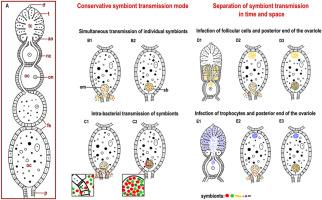永远在一起:飞虱垂直共生传播的模式和策略。
IF 2.1
3区 生物学
Q2 DEVELOPMENTAL BIOLOGY
引用次数: 0
摘要
昆虫拥有各种各样的微生物共生体,包括细菌和真菌,这些共生体通过补充必需的营养物质和帮助适应不同的生态位,有助于昆虫的生存。代际间的共生传播模式,特别是垂直传播,在维持这些互惠关系中起着核心作用。在这篇综述中,我们重点研究了细菌共生体在飞虱(Fulgoromorpha)中的传播机制,飞虱是一种以液为食的昆虫,严重依赖于专性的营养共生体来进行氨基酸的生物合成。这些共生体通过子房传播,祖先和新获得的共生体利用不同的垂直传播策略。在这里,我们描述了古Sulcia和Vidania共生体的保守传播模式,并展示了包括Sodalis和Acetobacteraceae在内的较近的伙伴如何采用不同的传播途径。此外,我们还讨论了沃尔巴克氏体和立克次体等兼性共生体的传播策略,说明了不同昆虫物种之间传播途径的多样性。最后,我们讨论了长期的、严格垂直的共生传播的进化后果。本文综述了目前关于飞虱共生遗传的研究进展,并对今后昆虫-微生物共生研究的重点领域进行了展望。本文章由计算机程序翻译,如有差异,请以英文原文为准。

Together forever: patterns and strategies of vertical symbiont transmission in planthoppers
Insects host a wide variety of microbial symbionts, including bacteria and fungi, which contribute to their survival by supplementing essential nutrients and aiding in adaptation to diverse ecological niches. The mode of symbiont transmission between generations, particularly vertical transmission, plays a central role in maintaining these mutualistic relationships. In this review, we focus on the transmission mechanisms of symbionts in planthoppers (Fulgoromorpha), a group of sap-feeding insects that rely heavily on obligate, nutritional symbionts for amino acid biosynthesis. These symbionts are transmitted through the ovary, with ancestral and newly acquired symbionts utilizing distinct strategies for vertical transmission. Here, we describe the conservative transmission mode for the ancient Sulcia and Vidania symbionts and show how more recent associates, including Sodalis and Acetobacteraceae, may adopt varied transmission routes. Moreover, we discuss the transmission strategies of facultative symbionts like Wolbachia and Rickettsia, illustrating the diversity of transmission pathways across different insect species. Lastly, we discuss the evolutionary consequences of long-term, strictly vertical symbiont transmission. This review synthesizes current knowledge on symbiont inheritance in planthoppers and identifies key areas for future research on insect-microbe symbioses.
求助全文
通过发布文献求助,成功后即可免费获取论文全文。
去求助
来源期刊

Developmental biology
生物-发育生物学
CiteScore
5.30
自引率
3.70%
发文量
182
审稿时长
1.5 months
期刊介绍:
Developmental Biology (DB) publishes original research on mechanisms of development, differentiation, and growth in animals and plants at the molecular, cellular, genetic and evolutionary levels. Areas of particular emphasis include transcriptional control mechanisms, embryonic patterning, cell-cell interactions, growth factors and signal transduction, and regulatory hierarchies in developing plants and animals.
 求助内容:
求助内容: 应助结果提醒方式:
应助结果提醒方式:


